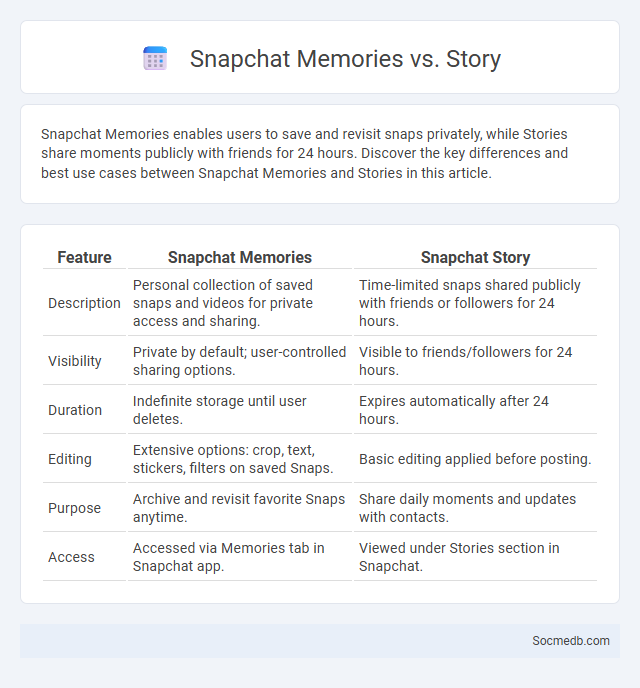
Photo illustration: Snapchat Memories vs Story
Snapchat Memories enables users to save and revisit snaps privately, while Stories share moments publicly with friends for 24 hours. Discover the key differences and best use cases between Snapchat Memories and Stories in this article.
Table of Comparison
| Feature | Snapchat Memories | Snapchat Story |
|---|---|---|
| Description | Personal collection of saved snaps and videos for private access and sharing. | Time-limited snaps shared publicly with friends or followers for 24 hours. |
| Visibility | Private by default; user-controlled sharing options. | Visible to friends/followers for 24 hours. |
| Duration | Indefinite storage until user deletes. | Expires automatically after 24 hours. |
| Editing | Extensive options: crop, text, stickers, filters on saved Snaps. | Basic editing applied before posting. |
| Purpose | Archive and revisit favorite Snaps anytime. | Share daily moments and updates with contacts. |
| Access | Accessed via Memories tab in Snapchat app. | Viewed under Stories section in Snapchat. |
Introduction to Snapchat’s Core Features
Snapchat offers distinctive core features including ephemeral Snaps, Stories, and interactive Lenses designed to enhance real-time communication and creativity. You can leverage its Discover section to stay updated with trending news, entertainment, and curated content from popular brands. These tools collectively foster a dynamic and engaging social media experience tailored for personal expression and instant sharing.
What Are Snapchat Memories?
Snapchat Memories is a feature that allows users to save snaps and stories directly within the app for easy access and sharing later. It organizes saved content into categories such as Snaps, Stories, and Camera Roll, providing a private archive that can be revisited and edited. Users can also create custom stories or backup their data to the cloud, enhancing content preservation and seamless reposting.
Understanding Snapchat Stories
Snapchat Stories allow users to share short, ephemeral videos and images visible to their friends for 24 hours, fostering real-time engagement and authentic communication. Your understanding of Snapchat Stories includes recognizing their interactive features like filters, lenses, and stickers that enhance content personalization. Mastering these tools can increase your social media presence by encouraging viewer interaction and timely content sharing.
Key Differences: Memories vs Stories
Memories on social media serve as static snapshots or posts that capture specific moments, remaining accessible on a user's profile unless deleted. Stories, in contrast, are ephemeral content formats that disappear after 24 hours, encouraging real-time sharing and engagement through interactive features like polls and stickers. The key difference lies in longevity and interactivity, with memories providing a lasting digital archive while stories offer dynamic, immediate experiences.
Privacy and Accessibility Comparison
Social media platforms vary widely in privacy settings and accessibility options, impacting user control over personal data and ease of use for people with disabilities. You can customize privacy levels on Facebook, Instagram, and Twitter, but Facebook offers the most granular controls, including audience selectors and activity logs. Accessibility features such as screen reader compatibility and text-to-speech are prominent on Twitter and Instagram, enhancing user experience for those with visual impairments.
Editing and Sharing Options
Social media platforms offer diverse editing tools that enhance Your content's visual appeal, including filters, cropping, and text overlays. Advanced sharing options allow you to control audience visibility, schedule posts, and cross-post across multiple networks seamlessly. These features empower creators to tailor their messages and maximize engagement efficiently.
Content Longevity: Memories and Stories
Content longevity on social media is deeply tied to how memories and stories are shared and preserved. Posts that evoke personal memories or narrate compelling stories tend to generate sustained engagement and repeated interactions over time. Platforms like Facebook and Instagram enhance content longevity through features such as memories reminders and story archives that encourage users to revisit and reshare meaningful moments.
Use Cases: When to Use Memories vs Stories
Memories are ideal for revisiting and sharing past moments, offering a way to archive significant events and personal milestones that users want to preserve long-term. Stories are best suited for real-time updates or spontaneous content, enabling users to engage their audience with fleeting, time-sensitive posts that disappear after 24 hours. Choosing between Memories and Stories depends on whether the content is meant for lasting reflection or immediate, ephemeral interaction.
Benefits and Drawbacks of Each Feature
Social media platforms offer diverse features such as instant messaging, video sharing, and live streaming, each enhancing user engagement and connectivity. Instant messaging fosters real-time communication but may reduce face-to-face interactions, while video sharing boosts visual storytelling yet raises privacy concerns. Live streaming provides immediate audience interaction, your content can reach broader audiences, but it also risks exposure to negative comments and misinformation.
Choosing the Right Feature for Your Needs
Selecting the right social media feature depends on your specific goals, whether it's engagement, brand awareness, or lead generation. Features like Stories, Reels, and Live Video cater to real-time interaction and authentic content, while Analytics tools provide data-driven insights to optimize performance. Understanding your audience preferences and platform capabilities ensures you leverage the most effective tools for maximum impact.
 socmedb.com
socmedb.com